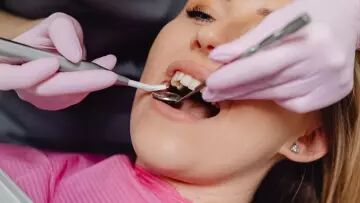This is a common question that a lot of patients ask when they come in to the dentist. The order in which you brush or clean interdentally makes no difference the most important thing is that you do a good job.
Brushing will only clean 60% of tooth surfaces so it is important to ensure that you also use an interdental cleaning aids to clean between your teeth where brushing misses. The key is to ensure that you remove the plaque that constantly builds up on your teeth. If left this plaque can lead to gum disease, decay and bad breath. Gum disease is the leading cause of tooth loss in adults in the UK.
Toothbrushing
Choose a toothbrush that feels comfortable in your hand and in your mouth, and use it twice a day with a fluoride toothpaste. It is recommended that you use a soft bristled brush as this will ensure that you do not cause damage to the teeth and gums by brushing too hard. Plaque although sticky is soft so does not require great force to remove it. Place your toothbrush at a 45-degree angle against the gums. Move the brush back and forth gently in short (tooth-wide) strokes brushing the outer tooth surfaces, the inner tooth surfaces, and the chewing surfaces of the teeth as well as the inside surfaces of the front teeth. Follow a set brushing pattern to ensure that you do not miss any areas.
Interdental cleaning
It is possible to use floss, tape or interdental brushes to clean between your teeth.
Flossing and Tape
Dental floss or tape can be effective when the gaps between your teeth are very small.
Take about 18 inches of floss and wind some around your middle finger of both hands.
Hold the floss between your thumb and your forefingers, with about an inch of floss between them. Use a gentle rocking motion to guide the floss between your teeth. Ensure that you do not jerk or snap the floss into your gums.
When the floss reaches the gum-line, curve it into a c shape against one tooth until you feel resistance. Hold the floss against the tooth and gently scrape the side of the tooth, gradually moving the floss away from the gum. Repeat on the other side of the gap along the side of the next tooth.
Inter-dental Brushing
The dentist or hygienist will be able to advise you on the best size interdental brush, depending on the size interdental brush, depending on the size of the gaps between your teeth. Brushes should never be forced into a space but the bristles need to make contact with the teeth and gums in order to remove plaque.
Hold the inter-dental brush between your thumb and forefinger. Gently place the brush through the gap between your teeth. Once inserted gently move the brush backwards and forwards a few times to remove plaque and debris.
Always rinse the brush in clean water after use. It is recommended that interdental brushes are changed every week or when the bristles become worn or wires become buckled or distorted. Undue force and bending at severe angles will lead to damage of the wire.
Remember in order to help ensure good oral health aim to floss or use inter-dental brushes once a day, as well as brushing with a fluoride toothpaste twice a day.
If you have any questions do not hesitate to ask the dentist on your next visit to the surgery. Call Leigh Dental Centre today on 01702 472929 and book a consultation.
Contact us to make an appointment
Exclusive Offer
Airflow stain removal from our hygienist


Stress and oral health
07.04.2023

6 Tips To Get Rid Of Bad Breath
04.02.2023
Time for you perfect smile?
Book your consultation today
When visiting our practice you know you are visiting the dental professionals trained to the highest standards. You are greeted by our welcoming staff, who share the same aim, to make your visit with us as comfortable and stress free as possible.





